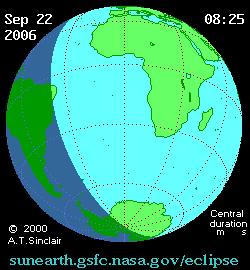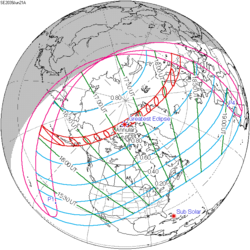| Annular eclipse | |
 Partial from São Paulo, Brazil | |
| Gamma | −0.4062 |
|---|---|
| Magnitude | 0.9352 |
| Maximum eclipse | |
| Duration | 429 s (7 min 9 s) |
| Coordinates | 20°36′S9°06′W / 20.6°S 9.1°W |
| Max. width of band | 261 km (162 mi) |
| Times (UTC) | |
| Greatest eclipse | 11:41:16 |
| References | |
| Saros | 144 (16 of 70) |
| Catalog # (SE5000) | 9522 |
An annular solar eclipse occurred at the Moon's descending node of orbit on Friday, September 22, 2006, [1] [2] [3] with a magnitude of 0.9352. A solar eclipse occurs when the Moon passes between Earth and the Sun, thereby totally or partly obscuring the image of the Sun for a viewer on Earth. An annular solar eclipse occurs when the Moon's apparent diameter is smaller than the Sun's, blocking most of the Sun's light and causing the Sun to look like an annulus (ring). An annular eclipse appears as a partial eclipse over a region of the Earth thousands of kilometres wide. Occurring about 5 hours after apogee (on September 22, 2006, at 6:20 UTC), the Moon's apparent diameter was smaller. [4]
Contents
- Images
- Eclipse timing
- Places experiencing annular eclipse
- Places experiencing partial eclipse
- Eclipse details
- Eclipse season
- Related eclipses
- Eclipses in 2006
- Metonic
- Tzolkinex
- Half-Saros
- Tritos
- Solar Saros 144
- Inex
- Triad
- Solar eclipses of 2004–2007
- Saros 144
- Metonic series
- Tritos series
- Inex series
- References
- External links
The path of annularity of this eclipse passed through Guyana, Suriname, French Guiana, the northern tip of Roraima and Amapá of Brazil, and the southern Atlantic. A partial eclipse was visible for parts of South America, West Africa, Southern Africa, the Antarctic Peninsula, and east Antarctica.












































































































